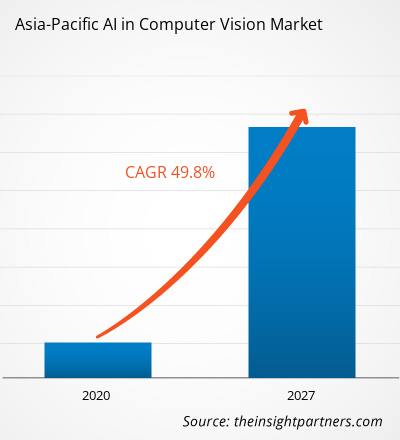The AI in computer vision market in APAC is expected to grow from US$ 1,156.92 million in 2019 to US$ 27,754.01 million by 2027; it is estimated to grow at a CAGR of 49.8% from 2020 to 2027.
Australia, China, India, Japan, and South Korea are major economies in APAC. Although innovations, such as the Internet of Things, are revolutionizing the manufacturing industry and making processes more autonomous, AI in computer vision would help improve them further. Computer vision is playing a significant part in inspecting fabricated products for flaws and non-conformities. Thus, on the production line, it may remove the need for human inspection, which is significantly increasing the adoption of AI in computer vision technology across the market. Similarly, edge computing solves the dilemma of latency and network usability. Devices can currently be set up in places where a network link is bad or non-existent without considering the connectivity. In addition, edge computing would offset some of the costs of using and managing cloud computing for data sharing. These factors are expected to drive the APAC AI in computer vision market during the forecast period.
Because of a massive number of cases in China, the APAC region is greatly affected by COVID-19, the country is the most important manufacturer and industrial producer because it trades more manufacturing products than any other country in the world; it is also a world leader in many types of goods. According to the Organization for Economic Co-operation and Development (OECD), the pandemic has also affected other major economies outside China, such as the large South Korea, India, Australia, and Japan, and is experiencing downward inflation.The sudden closedown of all economic activities which includes manufacturing and processing amongst others has highly impacted the growth of the region. Owing to severe burden of losses over manufacturing companies, the investment on new technologies and implementation of the same will now be deferred till they resume back to normal. This is expected to negatively impact the AI in computer vision market growth. However, the rising adoption of the technology across the healthcare sector to determine symptoms of covid-19 strains are influencing its high adoption across the countries to combat the rapid spread of the virus. Thus, the mixed effect of the technology across various industries is expected to moderately impact the market growth over the years across the region.
With the new features and technologies, vendors can attract new customers and expand their footprints in emerging markets. This factor is likely to drive the APAC AI in computer vision market. The Asia Pacific AI in computer vision market is expected to grow at a good CAGR during the forecast period.
- This FREE sample will include data analysis, ranging from market trends to estimates and forecasts.
APAC AI in Computer Vision Market Segmentation
APAC AI in Computer Vision Market – By Component
- Software
- Hardware
APAC AI in Computer Vision Market – By End-User
- Automotive
- Sports and Entertainment
- Robotics and Machine Vision
- Security and Surveillance
- Government and Defense
- Others
APAC AI in computer vision Market, by Country
- Australia
- China
- India
- Japan
- South Korea
- Rest of APAC
APAC AI in computer vision Market - Companies Mentioned
- 1.6 Xilinx, Inc.
- Allied Vision Technologies GmbH
- Basler AG
- Cognex Corporation
- General Electric Company
- Intel Corporation
- Microsoft Corporation
- Nvidia Corporation
- Qualcomm Incorporated
- Teledyne Technologies, Inc
Asia-Pacific AI in Computer Vision Report Scope
| Report Attribute | Details |
|---|---|
| Market size in 2019 | US$ 1,156.92 Million |
| Market Size by 2027 | US$ 27,754.01 Million |
| Global CAGR (2020 - 2027) | 49.8% |
| Historical Data | 2017-2018 |
| Forecast period | 2020-2027 |
| Segments Covered |
By Component
|
| Regions and Countries Covered | Asia-Pacific
|
| Market leaders and key company profiles |
- Historical Analysis (2 Years), Base Year, Forecast (7 Years) with CAGR
- PEST and SWOT Analysis
- Market Size Value / Volume - Global, Regional, Country
- Industry and Competitive Landscape
- Excel Dataset


- Authentication and Brand Protection Market
- Artificial Intelligence in Defense Market
- Sleep Apnea Diagnostics Market
- Pipe Relining Market
- Ceramic Injection Molding Market
- Blood Collection Devices Market
- Data Center Cooling Market
- Emergency Department Information System (EDIS) Market
- Cell Line Development Market
- Intraoperative Neuromonitoring Market

Report Coverage
Revenue forecast, Company Analysis, Industry landscape, Growth factors, and Trends

Segment Covered
Component and End-User

Regional Scope
North America, Europe, Asia Pacific, Middle East & Africa, South & Central America

Country Scope
Australia, China, Japan, South Korea
Trends and growth analysis reports related to Technology, Media and Telecommunications : READ MORE..
The List of Companies - Asia Pacific AI in Computer Vision Market
- 1.6 Xilinx, Inc.
- Allied Vision Technologies GmbH
- Basler AG
- Cognex Corporation
- General Electric Company
- Intel Corporation
- Microsoft Corporation
- Nvidia Corporation
- Qualcomm Incorporated
- Teledyne Technologies, Inc.

 Get Free Sample For
Get Free Sample For